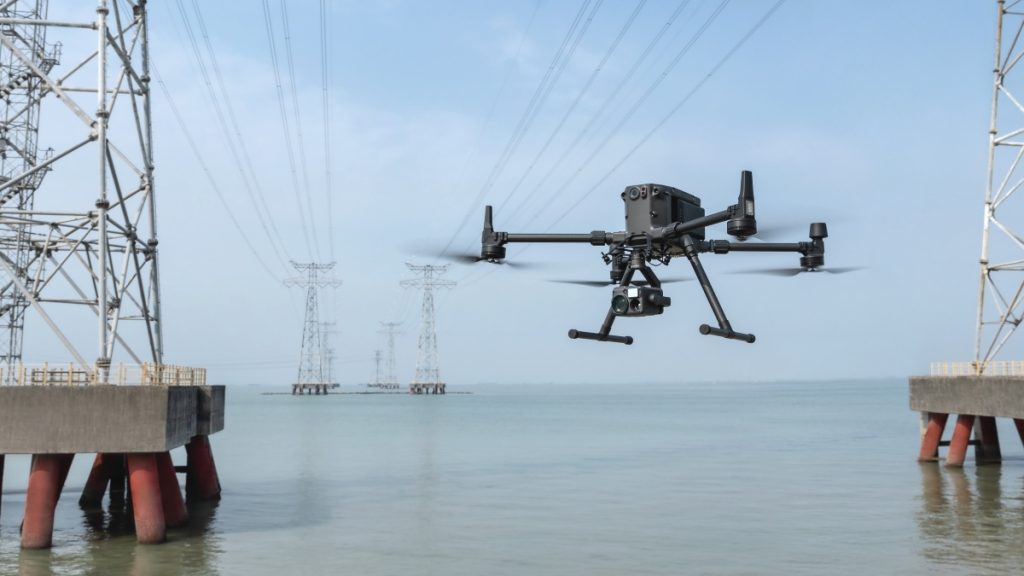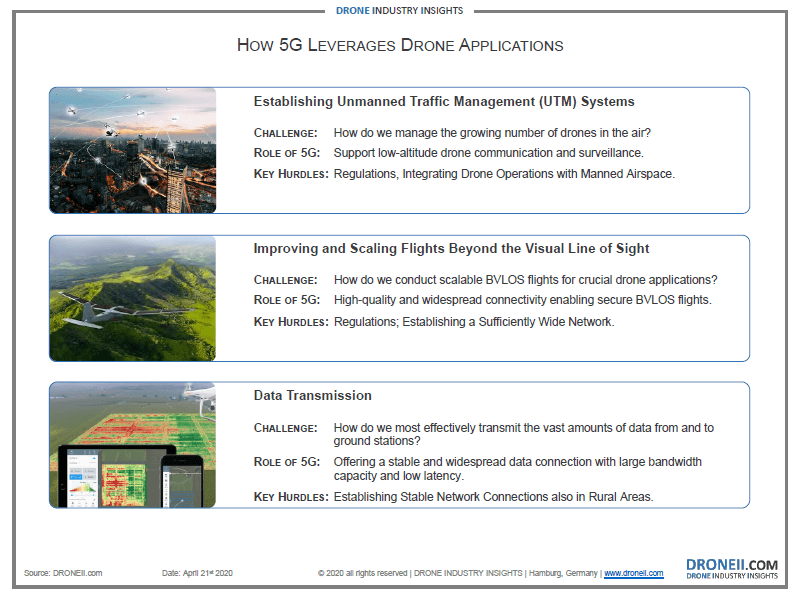Drones and 5G—The Future of Data Transmission
BY Zacc Dukowitz
28 May 2020For the last several months, the drone industry has been buzzing about 5G and its implications for drones. Drone Industry Insights (DII) alone has published two different reports on the topic since the start of the year, and several other industry publications have weighed in as well.

Photo credit: DJI
So what is 5G and why does it matter for drones?
5G stands for “fifth generation” and refers to the newest standard for mobile internet networks. It represents a significant upgrade from 4G, just as every previous standard iteration has been an upgrade from the one before it.
5G networks are already up and running in some cities here in the U.S., as well as in Switzerland and South Korea. Other countries, like Germany, have yet to implement 5G but should be doing so over the next year.
How 5G Will Benefit the Drone Industry
Speed is the standout feature of 5G. 5G networks use a New Radio standard, which leverages higher radio frequencies to transfer bigger amounts of data more quickly.
Put simply, 5G is 100 times faster than 4G, with 5 times lower latency.
What is latency? Latency is measured in milliseconds, and represents the time it takes for data to go from a source to a destination (i.e., the time it takes to upload data from a device to a target). 4G has an average latency of about 50ms, while 5G will have an average latency of 1ms.
While 4G theoretically reaches 100 megabits per second (Mbit/s), 5G could reach over 10 gigabits per second (Gbit/s) with an average of 100 Mbits/s.
The amped-up speed and lower latency of 5G are the main reasons people in the drone industry are talking so much about it.
That’s because drones collect a lot of data. And the ability to quickly transmit that data has the potential to significantly improve several aspects of drone technology, including:
- Enabling Artificial Intelligence. AI technology relies on huge amounts of data in order to recognize patterns. With a 5G network speeding up data transmission, drones could be equipped with onboard AI systems that could create a significant step forward for drone capabilities.
- Real-time high-def streaming. 5G allows drones to transmit HD footage 100 times faster than 4G, providing pilots with high quality imaging in real time. This improvement in real-time imaging quality could be useful for a number of commercial use cases, including inspections, public safety, agriculture, conservation, news reporting—really, any application that could benefit from getting high quality visual data delivered much faster than it can be now.
- Improving air traffic intelligence. 5G’s incredibly fast speed could also be helpful with monitoring the skies, since any lag in the transmission of a drone’s exact location will be significantly reduced. This real-time transmission of a drone’s actual location in the air could help improve safety by allowing for more accurate tracking of drones and drone fleets.
- Live streaming drone races. Although many drone applications could be enhanced by improved speeds with live streaming, 5G could literally change the face of drone racing by allowing for continual, high quality FPV streaming, potentially expanding the audience to appeal to new viewers.
In addition to the above benefits, Drone Industry Insights has three major needs that 5G can address for drones, which are UTM, BVLOS, and data transmission.

Source: Drone Industry Insights
Verizon’s Commitment to Connect 1 Million Flights
Although every major telecommunications company has an eye on the intersection between drones and 5G, Verizon is the main company making a big bet on drones.
For instance, check out this ad from Verizon highlighting the benefits of 5G for public safety agencies.
Verizon is not just jumping on the bandwagon here.
The company has had drones on its mind since as far back as 2016, when it first announced a plan to sell wireless data for drones.
Not long after that announcement, Verizon bought drone fleet management company Skyward, effectively doubling down on its drone interest. Since that acquisition Verizon has also invested in the creation of a network-based remote ID solution through Skyward, along with Wing, Uber, CNN, and AiRXOS.
We knew early on that connectivity would be critical for drones to truly transform our world. And now 5G Ultra Wideband will usher in a new era in aviation, where we connect and integrate drones into the national airspace.
– Mariah Scott, President of Skyward
In an ambitious statement made at CES in 2019, Verizon CEO Hans Vestberg announced the company’s “commitment to be the first to connect 1 million drone flights to the 5G network.”
While the company is still a long way from connecting one million drones to 5G, the statement itself reflects the importance of 5G for drones and how much Verizon understands this.
Do you think 5G will be a game changer for the drone industry? Share your thoughts in this thread on the UAV Coach community forum.


